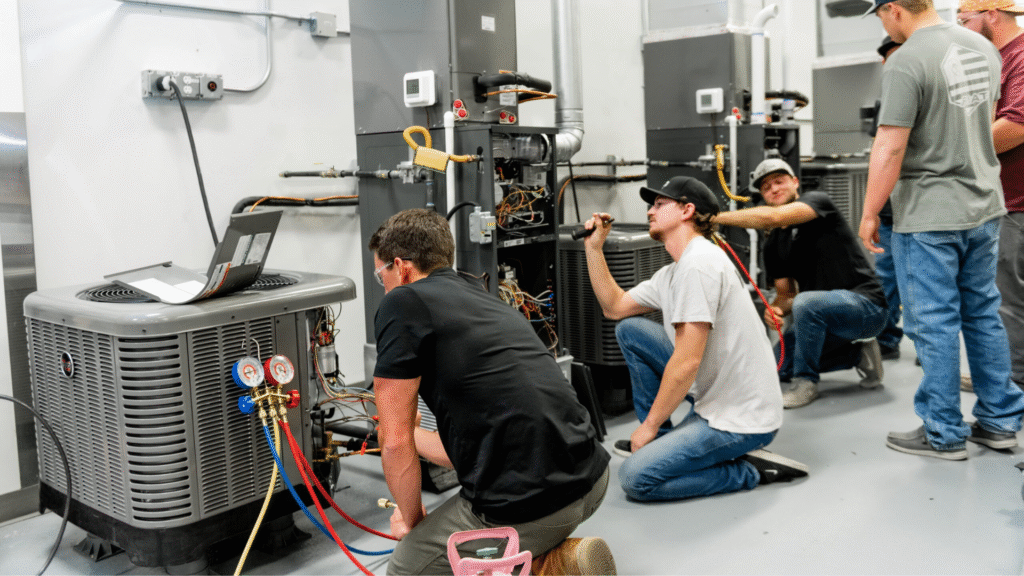How technology can help contractors manage energy incentives with TradeKnight, Sealed, and Coral CEOs
Notes on rebate programs, their complexity, and how technology can help contractors manage them

Image: Lauren Salz, Kyle Brack, Samir Pendse
❝
There are so many amazing rebate and incentive programs out there today, but every program is different — there’s no uniform standard… The process can be complex and time-consuming.
Kyle Brack, Lauren Salz, and Samir Pendse are the CEOs of TradeKnight, Sealed, and Coral.
TradeKnight is a service platform that pairs its contractor partners with cutting-edge technologies, Sealed is a climate tech company focused on enabling contractors to install more electrification projects, and Coral is a startup that makes financing sustainable home upgrades more accessible and affordable.
In separate conversations, we talked about national and local incentive programs, their problems, how technology can play a key role in helping contractors take advantage of them, and more. Our conversations were combined and lightly edited for brevity.
How do you think about the pain points that your companies are solving?
Kyle: From a contractor’s perspective, the first thing is figuring out what rebates are available. For those who aren’t aware, dsireusa.org is a great place to start. Second, it’s how are those rebates calculated, and when are they paid? And then, how are they managed, and what paperwork goes along with that?
Samir: I’d echo all of those. Another is, “What are the specific action steps that need to be taken to claim the rebate?” There is also a structural delay in receiving incentives. Contractors have to wait months to actually get the rebate, which is a huge challenge.
Lauren: There are so many amazing rebate and incentive programs out there today, but every program is different — there’s no uniform standard. On top of that, programs change all the time, which means you need to stay on top of it. The process can be complex and time-consuming, involving a lot of paperwork; it’s just hard to get some of these rebates, and as a contractor, there’s no one you can call.
The other really big one for contractors is payment timing. Sometimes, you’ll get lucky and get paid in two weeks, and sometimes it’s six months.
Why is technology important in solving those problems?
Samir: If a contractor brings the entire incentive management process in-house, depending on their size, they might hire 1-3 employees just to manage all the paperwork, and that’s very complex and labor intensive. Technology that can automate those processes and free up hours can be really valuable.
Lauren: We know contractors who have their sales team doing a lot of this work, and for someone who’s selling, that isn’t efficient. Imagine how much more they could generate if they just focused on selling. With the IRA rebates, there are different types of incentives: point-of-sale, modeled, and measured rebates. Energy modeling is complicated and very time-consuming. And a contractor’s not in a great position to measure energy savings, so that’s where we come in.
Kyle: Bottom line, the customer gets a better experience through transparency of rebates available and the best pricing, and the contractor wins through increased close rates without having a large back-office burden.
Can you walk me through an example of how a contractor uses your product?
Samir: Absolutely, let’s start with a contractor at the kitchen table with the homeowner. [A contractor] can instantly identify all the available rebates and eligible tax credits based on the homeowner's location, income, and possible replacement units. Next, we guide the contractor through action steps to guarantee eligibility for the rebate. Finally, we finance the rebate so contractors can deliver it as an upfront discount. The homeowner gets a lower price and doesn’t have to file for the rebate themselves, and the contractor is made whole right after the install.
Lauren: A contractor is in a customer’s home (who needs a new system), logs into our app, and inputs job and customer information. We tell the contractor how much they’re eligible for — and that’s based on how much we know the home will save based on our data. Then they can say, “Okay homeowner, you’re gonna get a $10,000 discount because of this rebate,” and assuming they’re successful at closing the job, that helps seal the deal. The customer then gets the discount at the point-of-sale and we pay the contractor within a couple weeks. That’s it, they don’t have to worry about the rebate ever again.
❝
I think a lot of contractors are scratching their heads a little and saying, “How else can I reduce this cost?” You have to look at these rebates now, and what technology does is allow you to do it without having to hire a full back office.
What can go wrong if a contractor mismanages the processing of rebates?
Lauren: We know a contractor who, before we started working with them, lost $300,000 by not knowing the program, incorrect paperwork, and not having the right signatures from the customer. There are lots of I’s and T’s that need to be crossed, and if you don’t have a tech solution to walk you through the process, it can be kind of risky.
Samir: I think the worst outcome for a contractor is mistakenly promising a credit or rebate that isn’t received. Every contractor has to be careful; if you overpromise, you can lose your reputation and brand. For the rebate, if the contractor says they installed an eligible system, and the rebate is denied, and the homeowner’s out that cash, that’s a major challenge. In the instances where the contractor’s floating the money, then they’re also just out for the rebate amount and that’s a direct hit on their business.
What are some objections that you hear from contractors?
Lauren: We want people to add rebates to their business. They want to, but they don’t want to hire more people to do it, and that’s a big reason why contractors don’t use rebate programs. And then also, depending on the scale, it just doesn’t pay off to hire a person.
Kyle: I think if you’re objecting, it’s because you don’t know how it solves the pain point. For those who don’t know the pain exists, they’re leaving money on the table.
Thoughts on contractors not wanting to get involved with rebate programs at all?
Kyle: For the last 3-5 years, that’s been easy to say because we’ve been in a low-interest rate environment and you have lenders offering 0% financing. The cost of upgrades was still relatively affordable. Now, if we’re in a 6-10% financing environment, that changes. Many consumers just can’t afford it, so we have to look for alternatives.
I think a lot of contractors are scratching their heads a little and saying, “How else can I reduce this cost?” You have to look at these rebates now, and what technology does is allow you to do it without having to hire a full back office. Lastly, I don’t think it’s an option anymore because, with the publicity around the IRA, customers are asking what’s available. This ‘pull’ dynamic means if you don’t have a solution to offer the best rebates available, then you just lose that customer.
Lauren: Well said!
❝
There will be technology and tools, but at the core, everything comes down to the technician and the relationship they build with homeowners.
How does implementation work for contractors?
Samir: Our contractor partners go live with Coral in less than three days. We have a program kickoff with training and provide ongoing support, but our platform is designed to integrate with existing workflows and be very low-lift for our partners.
Lauren: We do onboarding and training for all of our contractors and provide ongoing support. The salesperson is the primary person we train because they’re using it every day as a tool to help them close. We also train the admin and support teams, which includes letting us know the project’s been installed, getting a signature, and making sure we have your payment information.
Kyle: Every time you introduce a new tool, it’s about change management and communication. There are clear wins for the salesperson/comfort advisor, the customer, and the contractor's bottom line.
How do you see the Inflation Reduction Act (IRA) playing out in 2024?
Samir: Last time I checked, only four states have actually applied for the rebate programs, and I understand why many states want to wait, but four is less than we’d hoped. Applications will happen this year, but in much of the country, it’ll be 2025 before the rebates are live. I also think we’ll have to see more contractors — to fully capture these rebates — embrace the opportunity to serve low-to-moderate income communities, which the rebates are focused on.
Lauren: We don’t expect the first IRA dollars to be available until sometime in Q3, and we expect the bulk of states to launch in Q4. Especially with the election coming up, there’s a sense of urgency to accelerate that, but it’s really in the hands of the State Energy Offices right now. But what I’d encourage contractors to do in the meantime is see if there are any state/local incentives available and we can help guide you through the process.
There is $2 billion a year in rebates available that aren’t from the IRA — from state/local/utility programs. I think contractors who don’t use rebates once the IRAs are available will be at a competitive disadvantage.
What feedback have you gotten from contractors that’s helped you improve?
Samir: The goal has always been to give contractors more “arrows in their quiver”. We started with more of a rebate calculator, and we got the feedback that giving information isn’t nearly as valuable as being able to offer a tangibly lower upfront cost, which we can now deliver through our financing platform.
How do you actually calculate rebates?
Lauren: Information about the home as it is, information about the improvements being made, and energy usage data. The other relevant input is that in different areas, there are multipliers based on income.
Samir: The process differs by utility program or state. For example, in New York, you need to take a picture of the serial number and in Mass., you need a home energy assessment done before work is performed.
Anything else on your mind that we didn’t cover?
Samir: There will be technology and tools, but at the core, everything comes down to the technician and the relationship they build with homeowners. All of this technology is to take the other stuff off of their plate so they can focus on customer relationships and helping homeowners.
Lauren: I really think we covered everything!
📬 Get our stories in your inbox
Keep reading
90-day tariff pause brings some relief to the HVAC industry
The President on Wednesday announced a 90-day pause for over 75 countries, lowering their tariff rates to a flat 10 percent
House bill eases HVAC training costs
As part of the "big, beautiful bill" passed by the House, an education-focused savings plan will be expanded to include HVAC programs


